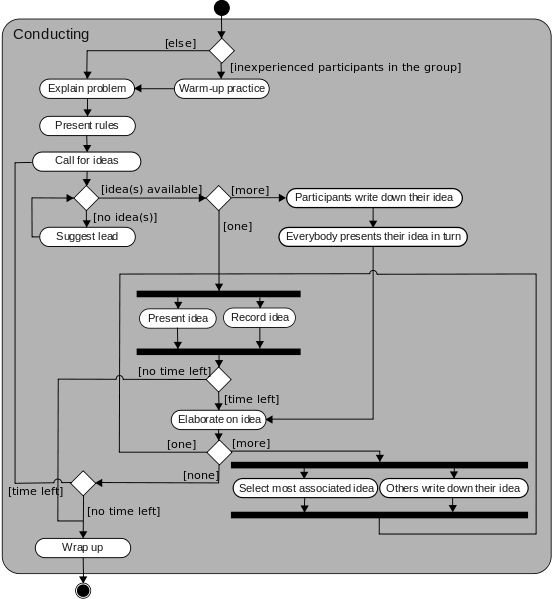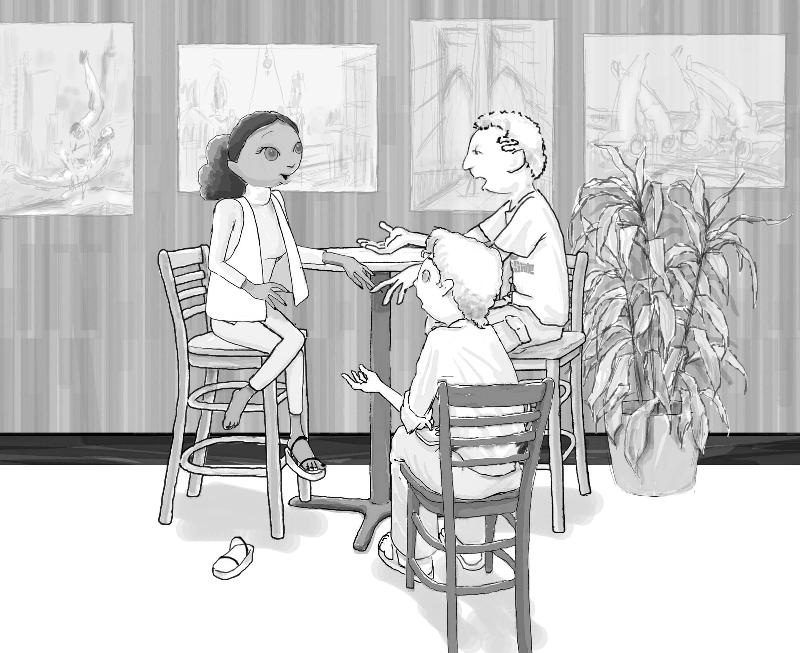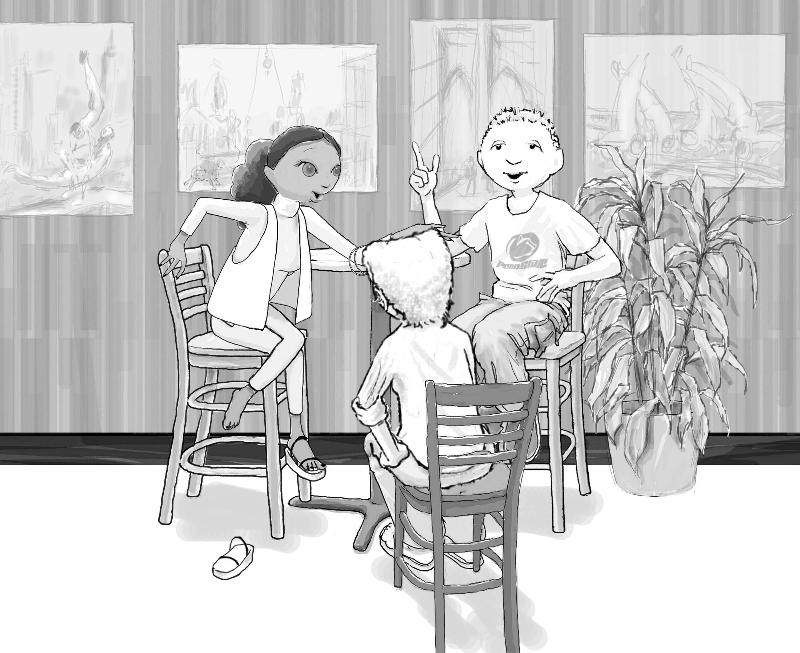
iStudy for Success!
Online learning tutorials for essential college skills.
Brainstorming is a way to generate ideas within a group setting. It is usually used in the beginning stages of a project, where the possibilities for the project are not clearly understood or defined. It provides a quick means for tapping the creativity of a limited number of people for a large number of ideas. The brainstorming environment fosters an uninhibited, non-judgmental explosion of ideas, concepts, policies, decisions, and strategies. In brainstorming, all contributions are valid, and the key to a successful session is to share as many ideas as possible without evaluating them. 
Brainstorming sessions can be unstructured - that is, there may not be a moderator or facilitator. Most sessions, however, are facilitated, structured discussions with guidelines to help the process move along smoothly and allow a variety of perspectives and ideas to surface.
Upon completion of this tutorial, you will be able to:
Read the information about brainstorming and complete the activities.
Note: All external links in this tutorial will open in a new window or tab.

 Brian: Now let's talk about how a brainstorming group can work well.
Brian: Now let's talk about how a brainstorming group can work well.
Heather: I think that there is a need to write down all ideas as they evolve.
Deena: How should it be done? Flip chart?
Brian: That would work. There are a lot of ways, like note cards.
Deena: Isn't the real point that ideas are recorded, not how?
Brian: Yeah. And that they are made available to all group members after they meet. I think the computer is the best recorder.
Heather: I agree, especially if there is a large number of people in the group. The drawback is that you have to have a computer.
Brian: Good point, not every group has a computer. I think Heather may have just brought up another issue, the size of the group. What do you mean by a large number of people, Heather? Got a number in mind?
Heather: Not really. I don't think there is any exact number that is defined as best for a brainstorming group. Certainly you would need at least two, or else it wouldn't be a group. I think somewhere between four and six would be just about right.
Brian: The key is that the group should have the right number of people to function effectively. Not too large or too small. Groups are different and what they want to accomplish is different also, so the proper size could vary.
Deena: But, you may not always have a choice in the size of your group. Correct?
Brian: Knowing that group size can influence a group's performance may help you and your group to identify problems and head them off.
Heather: I don't understand what you are getting at. Would you mind explaining what you are trying to say?
Brian: Have you ever been in a group where ideas someone presents are not clear because they are expressed in terms that are not understood?
Heather, Deena: Yeah!
Brian: Groups that have diverse backgrounds sometimes have a difficult time understanding an idea. In a group that doesn't know each other well, misrepresenting an idea could be an issue.
Brainstorming sessions are most successful when you make sure that certain factors exist before the beginning of a brainstorming session. These factors include:
Clues for determining the "right" group size:
Questions to keep in mind in order to make sure ideas are clear
Now let's practice some brainstorming by doing some role-playing. The following is a brainstorming scenario. Read the situation, then complete your part of the conversation.
|
The Situation UHS (University Health Service) staff members have a meeting about increasing the show-rate for medical appointments. According to a recent investigation, only 33% of students showed up for their appointments during the last semester. The staff members brainstorm potential solutions to improve the show-rate. Imagine you are the director of UHS and are attending the meeting. Director (You): How can we increase the show-rate for medical appointments? Staff 1: Make reminder calls before each appointment. Staff 2: How about giving incentives to students when they attend their appointment on time? What would you say next in response to the two staff members? |
Show/hide comprehension question...
Your response may have looked something like this: Maybe we could use a point system and give priority for future appointments to the students who regularly keep their appointments.
Techniques and rules used:
• Do not criticize or evaluate ideas.
Rule: Quantity is wanted - every idea is accepted and recorded. The more ideas, the more to choose from and the more likely ideas will spark new ideas.
• Build upon the ideas of other group members.
Rule: Combination and improvement are sought. Ideas spark more ideas. Encourage everyone to participate and to build upon the ideas of others in the group.
 Deena: How do we know if we maximized our efforts?
Deena: How do we know if we maximized our efforts?
Heather: We need to have checkpoints and evaluations.
Deena: That's what I'm getting at. We should have a way to know if things went well. That way we can improve our technique and be more efficient.
Heather: Do we evaluate during the session or at the end?
Deena: Maybe both.
Heather: If we do it during the session, it could slow things down because we would lose focus, and the freewheeling aspect that is needed could be disrupted.
Brian: I agree. I think looking at the group performance is appropriate. Looking at the ideas is another issue.
Deena: Maybe having a grasp of the performance points before the session begins will help us review the session at the end. If the session went well, then the content generated should be good, I would think.
Heather: So what do we want to do? What are some ideas for group's evaluating their performance?
Brian: To avoid evaluating presented ideas, we should make a list of ideal brainstorm session tactics to evaluate the group's performance in those areas. And add "thinking up ideas" and "broad topics" if that is OK with everyone.
Deena: Building and expanding on other's ideas.
Heather: Good one, Deena. I'd like to add, "getting everyone to participate" to the list.
Brian: I'm going to add, "listening to one another."
Heather: Another good thing to remember is the "critiquing of ideas" part. I'm adding that, too.
Brian: Has anyone noticed that Heather has been playing a duel role lately?
Deena: What do you mean, Brian?
Brian: Well, a mediator has to stay focused on the task so the group doesn't stray too far and at the same time encourage active participation. It just occurred to me that Heather has been doing that.
Deena: Good point! I think we should add, "how well the mediator functioned," which could also help evaluate if one was even in the group.
Brian: Without a doubt, there has to be a place for the group recorder and how well he or she did.
Heather: OK. I'll put that down. Next time, you be the recorder. I think that should be rotated also.
Brian: Could I suggest that since this is kind of like a self-survey, that we put each item in the form of a question? That way it works like a checklist. I think all I need to do is add the phrase, "How well did the group members..."
Deena: Works for me.
Heather: Me too.
Check your memory. Quiz yourself by completing the quiz below.

Select a topic, either in class or with a few friends. It can be a problem, a topic you are all interested in learning more about, or a plan for a project you have to do. Have everyone in the group take four or five minutes to write down everything you know about this topic.
While you are doing this, let your brain and imagination run loose. Write down everything. Don't worry about the order, categories, or even spelling. Relax, but write as fast as you can and don't stop.
When you are finished, compare the different lists and ideas. Are you surprised by the differences? Are there more similarities than differences? Did you discover you know more about the topic, problem, or project than you thought you did?
This is a good exercise to do on your own if you are, for example, having trouble deciding on a research paper topic or experiencing the common problem of not being able to get started writing a paper. Once you have generated your list, you can figure out what you know and what you don't know. You can make different categories and sub-categories. Then, you can decide how to go about finding out more.
Every method or technique you try as a group has its positive and not-so-positive components. Once you have at least one, and hopefully more than one, brainstorming experience, take a minute to think about how you felt as a participant, and record those thoughts.
Do you have ideas about how to make these experiences better? Do you have ideas about when you would or would not use brainstorming as a group process?
Andrew Delbecq and Andrew Van de Ven developed the Nominal Group Technique (NGT) because groups encounter many problems when trying to generate ideas, encourage high member involvement, and maintain agendas and time schedules. This activity will demonstrate another way to approach brainstorming, by using the NGT.
With a small group of friends or classmates, choose a topic for this activity. Then work through the following process:
1. Silent Generation of Ideas in Writing
Present the question or problem in written and verbal form. Give team members five to ten minutes to generate ideas in writing.
2. Recorded Round-Robin Listing of Ideas on Chart
Ask each member to read one of his/her ideas. Record this idea on a flip chart, whiteboard, blackboard, etc.
3. Discussion and Clarification of Each Idea on Chart
With each item, ask the team members if they have any questions, statements of clarification, or statements of agreement or disagreement they would like to share.
4. Preliminary Vote on Priorities
Ask each team member to silently pick five to seven of the "best" ideas, and rank them in order of importance. Members can use paper or index cards to do so. Then visually show these rankings on the flip chart, whiteboard, blackboard, etc.
5. Discussion of Preliminary Vote
Invite open discussion to examine inconsistent voting patterns and to provide an opportunity to readdress items which seemed to receive too many or too few votes.
6. Final Vote on Priorities
Repeat Step 4 to ensure the most important items are chosen and ranked appropriately. Display the results on the flip chart, whiteboard, blackboard, etc.
* Indicates that the original Website is no longer available.
Brainstorming sessions are most successful when you make sure that certain factors exist before the beginning of a brainstorming session. These factors include:
Clues for determining the "right" group size:
Questions to keep in mind in order to make sure ideas are clear
There are several questions that you should keep in mind during the evaluation of a brainstorming session.
Following are the assignments embedded in the Brainstorming tutorial:
This tutorial is related to other tutorials on personal effectiveness, including note-taking, active listening, active reading, time management, project management, academic research interviewing skills, stress management, conflict management, and peer tutoring.
Andrew Delbecq and Andrew Van de Ven developed the Nominal Group Technique (NGT) because groups encounter many problems when trying to generate ideas, encourage high member involvement, and maintain agendas and time schedules. This activity will demonstrate another way to approach brainstorming, by using NGT.
The instructor may want to choose (or let the students choose) a topic for this activity. The instructor should then guide the students through the following process:
1. Silent Generation of Ideas in Writing
Present the question or problem in written and verbal form. Give team members five to ten minutes to generate ideas in writing.
2. Recorded Round-Robin Listing of Ideas on Chart
Ask each member to read one of his/her ideas. Record this idea on a flip chart, whiteboard, blackboard, etc.
3. Discussion and Clarification of Each Idea on Chart
With each item, ask the team members if they have any questions, statements of clarification, or statements of agreement or disagreement they would like to share.
4. Preliminary Vote on Priorities
Ask each team member to silently pick five to seven of the "best" ideas, and rank them in order of importance. Members can use paper or index cards to do so. Then visually show these rankings on the flip chart, whiteboard, blackboard, etc.
5. Discussion of Preliminary Vote
Invite open discussion to examine inconsistent voting patterns and to provide an opportunity to readdress items which seemed to receive too many or too few votes.
6. Final Vote on Priorities
Repeat Step 4 to ensure the most important items are chosen and ranked appropriately. Display the results on the flip chart, whiteboard, blackboard, etc.
Note: This is an excellent opportunity to utilize and reinforce the cooperative learning techniques found in the Cooperative Learning tutorial. Instructors may want to construct small groups for this activity.
[top of page]
These points are covered in the tutorial, but should be emphasized in any discussion.
Through observing both the group's and the individuals' activities, the instructor may assess student performance. Assessment criteria are as follows (instructors supply the percentage weights):
|
Where |
Domain |
Activities |
% |
|---|---|---|---|
|
iStudy Tutorial |
Knowledge |
The student can identify common brainstorming techniques and rules and factors for successful brainstorming. |
|
|
iStudy Tutorial |
Application |
The student can apply brainstorming techniques and rules to new problem context during in-class activities. |
|
|
|
|
|
100% |